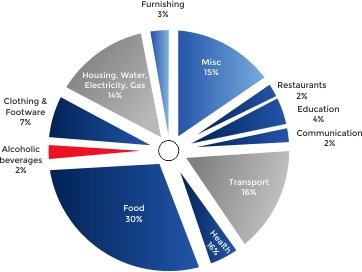
Content Creator
One of the largest democracies with a high potential is shining with a renewed vehemence. India, the land of vibrant cultures and talents is now a seat of critical business ventures and myriad of opportunities. From reforming policies to radical digitization, the country has evolved a lot in the past few years. As they say “ Well begun is already half-done”, India’s vision is clear and the future looks very bright.
In this article, we highlight key USPs of India and uncover several thematics to know why all eyes are upon this unprecedented subcontinent.
Some of the USPs of India
India boasts of being a country with the highest number of English-speaking individuals. This fact has ignited opportunities for foreign companies as better communication makes business conversations a cakewalk. 64% of the population comprises a strongly driven workforce most of whom are young talents. The younger generation is open to many alternative career opportunities. Contrary to this the preceding generation consisted of students who mostly aimed to work in industries like Software, Medicine, engineering, banking and finance and the security sector. Gen Z students are inclined towards having their own start-ups about travel, health, beauty and so on. No wonder, India ranks 3rd in the global start-up-index and has more than 100 Unicorns in 2022.
What do Indian millennials spend on?
Indian millennials spent mostly on cars, apartments, and consumer durables before the pandemic.
![UJA millennials are much more likely to purchase high value assets companerd to their old cohorts ]](https://uja.in/wp-content/uploads/2022/08/infographics-II.jpg)
Post-pandemic they have changed their spending habits considerably. The population has drifted away from huge investments and are inkling towards shared mobility.
This heralds usage of more apps like ola and uber and to capitalise on the same.

Rising industries in the last 3 years
As a fast-growing economy, India grew tremendously, through a series of economic mishaps and then recovery in the last few years. As part of the recovery process, some sectors saw marginal growth while others saw phenomenal success.
This section highlights industries that have risen and are thriving well in India since the past 3 years. India has seen a steadfast progress in these sectors and gone from strength to strength.
The FMCG & Healthcare Industry
With the incentives and PLI schemes initiated by the Government The FMCG sector is growing by leaps and bounds. The FMCG market in India was at a CAGR US$ 110 billion in 2020 and is expected to grow at the rate of 14.9% to reach US$ 220 billion by 2025. The Indian packaged food market is predicted to grow to US$ 70 billion by 2025. The healthcare sector including pharmaceuticals is booming at an accelerated rate. India’s Pharma exports have grown by 103% since 2014 especially in highly regulated markets in the US and EU. During Covid India exported drugs and pharmaceuticals worth USD 24.4 Bn with a YoY growth of 18%.
Through the Vaccine Maitri initiative export of vaccines alone accounted for USD 24.4 B7 enabling a YoY growth of 18%.
Additionally innovations in Artificial intelligence (AI), AR/VR, machine learning (ML) and additive manufacturing are propelling the growth in the healthcare industry.
Automotive Industry
The Automotive industry accounts for 7% of India’s GDP. With the world’s rising consciousness about the environment and to comply with the 2C mandate of the Paris agreement, the focus is towards electric vehicles. With the government’s USD 3.4 billion worth PLI scheme, many foreign entities in this sector as well as home-bound companies are investing in this sector. India is also a potential destination for shared mobility and is expected to grow phenomenally in this sector by 2030. On-the-go apps like Ola and Uber are preferred shared-mobility solutions for the population that is giving more importance to leading wholesome lives rather than possessing heavy-investment assets.
Software and Technology
The IT industry accounts for 8% of India’s GDP. India is at 46th rank in the Global Innovation Index (GII). India’s IT sector is expected to grow to US$ 227 billion in FY22.
The leading IT companies, TCS, Wipro and Infosys, are expected to offer employment opportunities to the scale of 1.05 lakh jobs in FY 2022. Not only exports, but India’s IT market’s demand is about US$ 101.8 billion in 2022.
The above three sectors as discussed are potential to India’s economic growth, and consumer behaviour and market trends are facilitating this coherently.
The Make in India policy, lucrative PLI schemes and incentives across industries are luring many foreign ventures from across the globe to set their foothold in India. At this point, “setting foothold” would be an understatement. Undoubtedly, we can say that they are thriving well in the country.
India’s population consisting of a massive middle-class population that speaks English makes it easier for these foreign ventures to set their manufacturing and R&D units in India. Several bilateral agreements and dialogues between India and her allies have strengthened business relationships further. The agile market that appreciates innovation is also an added advantage when it comes to marketing new technology, innovation and growth. Most of the countries also feel comfortable doing business in India because of simplification and digitization of paperwork and the reforms in taxation that have culminated various taxes under one umbrella of GST.
Let us look at a list of such companies country-wise:
To name just a few of them region-wise:
From the horse’s mouth
What do foreign companies think of when it comes to doing Business in India: With the highest recorded FDI inflows in India in 2022 ($83.57 billion) , no wonder India emerges as a promising land for several foreign companies. Apart from the foreign policies, Make in India initiatives and lucrative PLI schemes, there is a sizeable contribution of a positive attitude of the population encouraging such companies to excel in the country.
This section compiles testimonials from key players about what think about investing in India.
India’s growth: GDP: a concise analysis of what happened and how things geared up
India’s GDP plunged in 2020 sending across a series of shockwaves to the people. If we dig a little deeper the nitty-gritty comes to the fore.
GDP is calculated as the gross value of the domestic products produced in the country using the below formula:
Y (GDP) : Investment by firms + Consumption(house hold) +Govt expenditures + Net Exports (Exports – Imports) Or, Y: I + C + G + Nx
The below mentioned infographic highlights the segment wise contribution towards India’s GDP. As we can see, the services industry accounts for about 53.9% of the GDP and is the highest factor affecting it.

As was evident during the covid, expenditures and investment by consumers had been reduced to a bare minimum. FMCG and software products and solutions were the consumer’s highest priority. Other sectors like manufacturing, infrastructure, education and tourism had paused their business operations due to the extended lockdowns.
By 2020, last quarter, the construction and travel industries slightly started gearing-up their businesses enabling the GDP to positively surge slowly.
By 2021, tables turned in favour of India, with the production of Covid vaccines propelling the Net export of India to a record high pulling the GDP up the ladder.
India exported a whopping 170 million units of vaccines to about 96 countries.
The Serum Institute of India, Pune, accounted for 66.63 percent of Covishield vaccines to about 92 countries globally.
India capitalized on three factors to facilitate a spiralling export of vaccines:
GDP of India grew by 8.7% In 2021-22.
Undoubtedly, as a pivotal point, the “Make in India’ scheme has contributed to GDP substantially. The production-linked incentive schemes have been curated to boost manufacturing.
An infographic that shows the variation of GDP in the last 4 years:
an easy bar chart how the GDP fell and rose again to power.
As a unique nation, gushing through adversities, maximising opportunities and inventing novice ways of excelling, the country is in the forefront. The entire world is inclined towards unique opportunities, talent and trust this country offers at the outset. Through agile strategies and a positive disposition India is definitely looking forward to the bright future.
As Bobby Knight points out “The key is not the will to win, everybody has that. It is the will to prepare to win that is important.” what India has always stood for.
